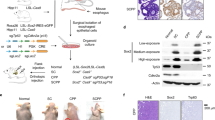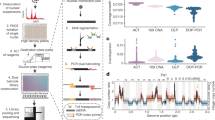Abstract
Normal human keratinocytes possess a finite replicative lifespan. Most advanced squamous cell carcinomas (SCCs), however, are immortal, a phenotype that is associated with p53 and INK4A dysfunction, high levels of telomerase and loss of heterozygosity (LOH) at several genetic loci, suggestive of the dysfunction of other mortality genes. We show here that human chromosome 6 specifically reduces the proliferation or viability of a human SCC line, BICR31, possessing LOH across the chromosome. This was determined by an 88% reduction in colony yield (P<0.001), following the reintroduction of an intact normal chromosome 6 by monochromosome transfer. Deletion analysis of immortal segregants using polymorphic markers revealed the loss of a 2.9 Mbp interval, centred on marker D6S1045 at 6q14.3–q15, in 6/19 segregants. Crucially, allelic losses of this region were not identified in control hybrids constructed between chromosome 6 and the BICR6 SCC cell line that is heterozygous for chromosome 6 and which showed no reduction in colony formation relative to the control chromosome transfers. This indicates that the minimally deleted region at D6S1045 is not the result of fragile sites, a recombination hot spot, or a feature of the monochromosome transfer technique. LOH of D6S1045 was found in 2/9 immortal SCC lines and was part of a minimally deleted region of line BICR19. Furthermore, allelic imbalance, consistent with LOH, was detected in 3/17 advanced SCCs of the tongue. These results suggest the existence of a suppressor of SCC immortality and tumour development at chromosome 6q14.3–q15, which is important to a subset of human SCCs.
This is a preview of subscription content, access via your institution
Access options
Subscribe to this journal
Receive 50 print issues and online access
$259.00 per year
only $5.18 per issue
Buy this article
- Purchase on Springer Link
- Instant access to full article PDF
Prices may be subject to local taxes which are calculated during checkout






Similar content being viewed by others
Abbreviations
- MMCT:
-
Microcell-mediated monochromosome transfer
- LOH:
-
loss of heterozygosity
- SCC:
-
squamous cell carcinoma
References
Azzalin CM, Mucciolo E, Bertoni L and Giulotto E . (1997). Cytogenet. Cell. Genet., 78, 112–115.
Banga SS, Kim S, Hubbard K, Dasgupta T, Jha KK, Patsalis P, Hauptschein R, Gamberi B, Dalla-Favera R, Kraemer P and Ozer HL . (1997). Oncogene, 14, 313–321.
Benitez J, Osorio A, Barroso A, Arranz E, Diaz-Guillen MA, Robledo M, Rodriguez de Cordoba S and Heine-Suner D . (1997). Cancer Res., 57, 4217–4220.
Casey G, Plummer S, Hoeltge G, Scanlon D, Fasching C and Stanbridge EJ . (1993). Hum. Mol. Genet., 2, 1921–1927.
Cheng Y, Poulos NE, Lung ML, Hampton G, Ou B, Lerman MI and Stanbridge EJ . (1998). Proc. Natl. Acad. Sci. USA, 95, 3042–3047.
Clark LJ, Edington K, Swan IR, McLay KA, Newlands WJ, Wills LC, Young HA, Johnston PW, Mitchell R and Robertson G et al. (1993). Br. J. Cancer, 68, 617–620.
Cooney KA, Wetzel JC, Consolino CM and Wojno KJ . (1996). Cancer Res., 56, 4150–4153.
Cuthbert AP, Bond J, Trott DA, Gill S, Broni J, Marriott A, Khoudoli G, Parkinson EK, Cooper CS and Newbold RF . (1999). J. Natl. Cancer Inst., 91, 37–45.
Cuthbert AP, Trott DA, Ekong RM, Jezzard S, England NL, Themis M, Todd CM and Newbold RF . (1995). Cytogenet. Cell Genet., 71, 68–76.
Edington KG, Loughran OP, Berry IJ and Parkinson EK . (1995). Mol. Carcinog., 13, 254–265.
Edwards NL, Magilavy DB, Cassidy JT and Fox IH . (1978). Science, 201, 628–630.
Engelman JA, Zhang XL, Lisanti MP . (1998). FEES Lett., 436, 403–410.
England NL, Cuthbert AP, Trott DA, Jezzard S, Nobori T, Carson DA and Newbold RF . (1996). Carcinogenesis, 17, 1567–1575.
Fantes JA, Oghene K, Boyle S, Danes S, Fletcher JM, Bruford EA, Williamson K, Seawright A, Schedl A and Hanson I et al. (1995). Genomics, 25, 447–461.
Forsyth NR, Morrison V, Craig NJ, Fitzsimmons SA, Barr NI, Ireland H, Gordon KE, Dowen S, Cuthbert AP, Newbold RF, Bryce SD and Parkinson EK . (2002). Oncogene, 21 (33), 5135–5147.
Fujikawa-Yamamoto K, Teraoka K, Zong ZP, Yamagishi H and Odashima S . (1994). Cell Struct. Funct., 19, 391–396.
Going JJ and Lamb RF . (1996). J. Pathol., 179, 121–124.
Green RJ, Phillips DL, Chen AT, Reidy JA and Ragab AH . (1988). Hum. Genet., 81, 9–12.
Guan XY, Horsman D, Zhang HE, Parsa NZ, Meltzer PS and Trent JM . (1996). Blood, 88, 1418–1422.
Hassfeld W, Chan EK, Mathison DA, Portman D, Dreyfuss G, Steiner G and Tan EM . (1998). Nucleic Acids Res., 26, 439–445.
Hatcher CJ, Kim MS, Mah CS, Goldstein MM, Wong B, Mikawa T and Basson CT . (2001). Dev. Biol., 230, 177–188.
Hensler PJ, Annab LA, Barrett JC and Pereira-Smith OM . (1994). Mol. Cell. Biol., 14, 2291–2297.
Jacobs JJ, Keblusek P, Robanus-Maandag E, Kristel P, Lingbeek M, Nederlof PM, van Welsem T, van de Vijver MJ, Koh EY, Daley GQ and van Lohuizen M . (2000). Nat. Genet., 26, 291–299.
Karlsson C, Stenman G, Vojta PJ, Bongcam-Rudloff E, Barrett JC, Westermark B and Paulsson Y . (1996). Cancer Res., 56, 241–245.
Koi M, Johnson LA, Kalikin LM, Little PF, Nakamura Y and Feinberg AP . (1993). Science, 260, 361–364.
Levy FO, Holtgreve-Grez H, Tasken K, Solberg R, Ried T and Gudermann T . (1994). Genomics, 22, 637–640.
Lo KW, Kwong J, Hui AB, Chan SY, To KF, Chan AS, Chow LS, Teo PM, Johnson PJ and Huang DP . (2001). Cancer Res., 61, 3877–3881.
Loughran O, Clark LJ, Bond J, Baker A, Berry IJ, Edington KG, Ly IS, Simmons R, Haw R, Black DM, Newbold RF and Parkinson EK . (1997). Oncogene, 14, 1955–1964.
Mandahl N . (1992). Human Cytogenetics, a Practical Approach. Vol. 2. Rooney DE and Czepulkowski BH (eds). IRL Press: Oxford, pp. 155–182.
Morelli C, Sherratt T, Trabanelli C, Rimessi P, Gualandi F, Greaves MJ, Negrini M, Boyle JM and Barbanti-Brodano G . (1997). Cancer Res., 57, 4153–4157.
Nathrath MH, Kuosaite V, Rosemann M, Kremer M, Poremba C, Wakana S, Yanagi M, Nathrath WB, Hofler H, Imai K and Atkinson MJ . (2002). Oncogene, 21, 5975–5980.
Ning Y, Weber JL, Killary AM, Ledbetter DH, Smith JR and Pereira-Smith OM . (1991). Proc. Natl. Acad. Sci. USA, 88, 5635–5639.
Ogata T, Ayusawa D, Namba M, Takahashi E, Oshimura M and Oishi M . (1993). Mol. Cell. Biol., 13, 6036–6043.
Parkinson EK, Newbold RF and Keith WN . (1997). Eur. J. Cancer, 33, 727–734.
Resta R, Yamashita Y and Thompson LF . (1998). Immunol. Rev., 161, 95–109.
Rimessi P, Gualandi F, Morelli C, Trabanelli C, Wu Q, Possati L, Montesi M, Barrett JC, Barbanti-Brodano G . (1994). Oncogene, 9, 3467–3474.
Robertson GP, Furnari FB, Miele ME, Glendening MJ, Welch DR, Fountain JW, Lugo TG, Huang HJ and Cavenee WK . (1998). Proc. Natl. Acad. Sci. USA, 95, 9418–9423.
Sandhu AK, Hubbard K, Kaur GP, Jha KK, Ozer HL and Athwal RS . (1994). Proc. Natl. Acad. Sci. USA, 91, 5498–5502.
Sandhu AK, Kaur GP, Reddy DE, Rane NS and Athwal RS . (1996). Oncogene, 12, 247–252.
Sasaki M, Honda T, Yamada H, Wake N, Barrett JC and Oshimura M . (1994). Cancer Res., 54, 6090–6093.
Sheng ZM, Marchetti A, Buttitta F, Champeme MH, Campani D, Bistocchi M, Lidereau R and Callahan R . (1996). Br. J. Cancer, 73, 144–147.
Stanton P, Richards S, Reeves J, Nikolic M, Edington K, Clark L, Robertson G, Souter D, Mitchell R, Hendler FJ et al. (1994). Br. J. Cancer, 70, 427–433.
Steenbergen RD, Kramer D, Meijer CJ, Walboomers JM, Trott DA, Cuthbert AP, Newbold RF, Overkamp WJ, Zdzienicka MZ and Snijders PJ . (2001). J. Natl. Cancer Inst., 93, 865–872.
Turker MS, Gage BM, Rose JA, Elroy D, Ponomareva ON, Stambrook PJ and Tischfield JA . (1999). Cancer Res., 59, 1837–1839.
Uejima H, Mitsuya K, Kugoh H, Horikawa I and Oshimura M . (1995). Genes Chromosomes Cancer, 14, 120–127.
Wang XW, Lin X, Klein CB, Bhamra RK, Lee YW and Costa M . (1992). Carcinogenesis, 13, 555–561.
Wu CL, Roz L, McKown S, Sloan P, Read AP, Holland S, Porter S, Scully C, Paterson I, Tavassoli M and Thakker N . (1999). Genes Chromosomes Cancer, 25, 16–25.
Yi CH, Terrett JA, Li QY, Ellington K, Packham EA, Armstrong-Buisseret L, McClure P, Slingsby T and Brook JD . (1999). Genomics, 55, 10–20.
Zhu Z, Yao J, Johns T, Fu K, De Bie I, Macmillan C, Cuthbert AP, Newbold RF, Wang J, Chevrette M, Brown GK, Brown RM and Shoubridge EA . (1998). Nat. Genet., 20, 337–343.
Acknowledgements
We thank Dr Andrew Mungall of The Sanger Centre, Wellcome Trust Genome Campus, Cambridgeshire, UK for helpful discussions regarding the sequencing of human chromosome 6 and provision of both PAC and BAC clones across our regions of interest. In addition, we thank Professor John Wyke for critical review of the article and the Association for International Cancer Research for the financial support of the work.
Author information
Authors and Affiliations
Corresponding author
Additional information
Supported by a grant to SAF and EKP from the Association for International Cancer Research, HI was supported by Glasgow University, NIB was supported by a grant to EKP from the Association for International Cancer Research, RFN and ACP by the Cancer Research UK.
Rights and permissions
About this article
Cite this article
Fitzsimmons, S., Ireland, H., Barr, N. et al. Human squamous cell carcinomas lose a mortality gene from chromosome 6q14.3 to q15. Oncogene 22, 1737–1746 (2003). https://doi.org/10.1038/sj.onc.1206295
Received:
Revised:
Accepted:
Published:
Issue Date:
DOI: https://doi.org/10.1038/sj.onc.1206295



